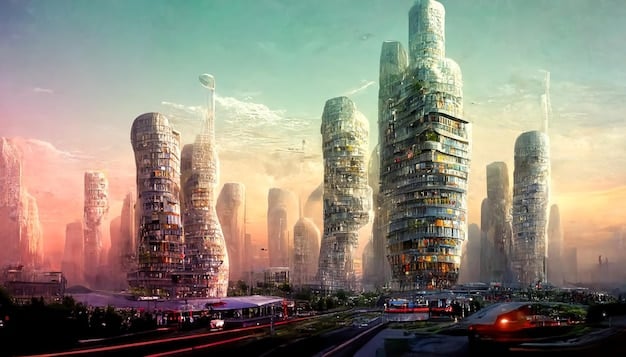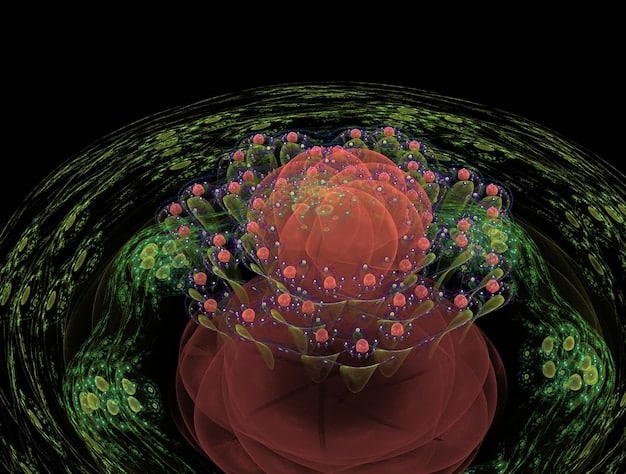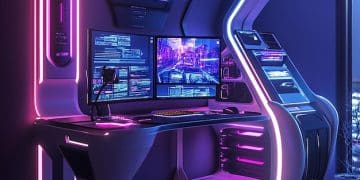Exploring the Potential of Neural Rendering in Next-Gen Games

Exploring the potential of neural rendering in next-gen games offers a revolutionary leap, enabling hyper-realistic graphics and dynamic environments previously unattainable, transforming the gaming experience for both developers and players.
The gaming industry is on the cusp of a visual revolution. Forget everything you thought you knew about graphics because neural rendering is poised to redefine what’s possible. Are you ready to explore the potential of this groundbreaking technology in next-gen games?
What is Neural Rendering?
Neural rendering represents a significant departure from traditional graphics rendering techniques. But what exactly *is* it, and why is everyone talking about it? Simply put, it uses neural networks to generate images, leveraging machine learning to create photorealistic and dynamic visuals.
Unlike conventional methods that rely on explicit 3D models and complex algorithms, neural rendering learns from data. It can synthesize new images from a limited set of inputs, enabling more efficient and realistic content creation. This difference is fundamental to Understanding the Potential of Neural Rendering in Next-Gen Games.
Key Components of Neural Rendering
- Neural Networks: The heart of neural rendering, responsible for learning and generating images.
- Training Data: Large datasets of images or videos used to train the neural networks.
- Rendering Pipeline: The process of using the trained neural network to create new images.
Neural rendering is a powerful tool that can unlock new levels of visual fidelity and efficiency in next-gen game development. It allows developers to create immersive experiences with greatly reduced resources.

Exploring the Potential of Neural Rendering in Next-Gen Games
Exploring the potential of neural rendering in next-gen games isn’t just about better graphics; it’s about fundamentally changing how games are made and experienced. This technology promises increased realism, dynamic environments, and more efficient development pipelines. But how does it all translate into tangible benefits?
One major advantage is the ability to create highly detailed and realistic characters and environments with significantly less manual effort. Neural rendering algorithms can learn from real-world data to generate assets that would otherwise be too time-consuming or expensive to produce.
Benefits of Neural Rendering in Games:
- Enhanced Realism: Achieve photorealistic graphics that mimic real-world visuals.
- Dynamic Environments: Create interactive and adaptable environments that respond to player actions.
- Efficient Content Creation: Reduce the time and resources required to develop high-quality assets.
Neural rendering also opens up new possibilities for procedural content generation. By training neural networks on existing game assets, developers can create vast and varied worlds with minimal manual intervention.
How Neural Rendering Works: A Deeper Dive
To fully appreciate the potential benefits, it’s important to understand how neural rendering actually works. While the underlying concepts can be complex, the core principles are relatively straightforward.
Generally speaking, neural rendering consists of two main stages: training and inference. During training, a neural network is fed a large dataset of images or videos. The network learns to map input data to output images, effectively learning how to generate new visuals based on the training data. The Inference state involves using previously trained Neural Networks to generate new images.
Key Techniques in Neural Rendering:
- Neural Radiance Fields (NeRFs): Represent 3D scenes as continuous functions, enabling photorealistic rendering from novel viewpoints.
- Differentiable Rendering: Allows optimization of scene parameters by backpropagating gradients through the rendering pipeline.
- Generative Adversarial Networks (GANs): Used to generate high-resolution textures and details, enhancing visual fidelity.
By combining these techniques, neural rendering can achieve unprecedented levels of realism and interactivity. The key is in training sophisticated neural networks on vast datasets. The results are extremely promising.

Challenges and Considerations
While the potential is immense, there are also significant challenges to consider when implementing neural rendering in next-gen games. Computational cost, data requirements, and artistic control are some of the key issues that developers must address.
One of the biggest hurdles is the high computational cost associated with training and running neural networks. Neural rendering algorithms often require powerful GPUs and specialized hardware, which can increase development costs. Another difficulty is the need for large, high-quality datasets. Neural networks need plenty of appropriate data.
Overcoming the Challenges:
- Optimization Techniques: Developing more efficient neural network architectures and training algorithms.
- Data Augmentation: Generating synthetic data to supplement real-world datasets.
- Hybrid Approaches: Combining neural rendering with traditional techniques to balance realism and performance.
Despite these challenges, the benefits of neural rendering are too significant to ignore. As technology advances and new solutions emerge, many of these challenges will be overcome.
The Future of Gaming: Neural Rendering and Beyond
Looking ahead, the future of gaming is inextricably linked to advancements in neural rendering. As the technology matures and becomes more accessible, it will transform nearly every aspect of game development and gameplay.
One exciting possibility is the creation of fully dynamic and interactive game worlds. Imagine environments that respond realistically to player actions, with materials that deform realistically and react to lighting. This is the promise when Considering the Potential of Neural Rendering in Next-Gen Games.
Potential Future Applications:
- Real-Time Ray Tracing: Combining neural rendering with ray tracing to achieve photorealistic lighting and reflections.
- AI-Driven Characters: Using neural networks to create more realistic and believable character animations.
- Personalized Gaming Experiences: Adapting game content and difficulty based on player behavior and preferences.
Neural rendering is not just a technological advancement; it’s a paradigm shift that will redefine what it means to play and create games. It is very likely to impact the future in a major fashion.
| Key Aspect | Brief Description |
|---|---|
| 💡 Neural Rendering | Uses neural networks to generate realistic images from data. |
| 🚀 Game Benefits | Enhances realism, enables dynamic environments, and boosts content creation efficiency. |
| ⚙️ Key Techniques | Includes NeRFs, differentiable rendering, and GANs for visual fidelity. |
| 🎮 Future Impact | Could lead to real-time ray tracing, AI-driven characters, and personalized experiences. |
Frequently Asked Questions
Neural rendering employs neural networks to generate images, learning from data to create photorealistic graphics. Traditional rendering relies on explicit 3D models and algorithms, potentially offering less realistic results.
NeRFs represent 3D scenes as continuous functions, enabling photorealistic rendering from novel viewpoints and creating visually enhanced gaming experiences.
Benefits include achieving enhanced realism, creating dynamic environments, and improving the efficiency of content creation within the game development process.
Challenges include high computational costs, the need for large training datasets, and maintaining artistic control over the generated visuals. Overcoming these requires optimization and innovation.
It could lead to real-time ray tracing, AI-driven characters, and personalized gaming experiences, revolutionizing both game development and the ways games are played.
Conclusion
Exploring the potential of neural rendering in next-gen games reveals a landscape ripe with possibilities. From enhanced realism and dynamic environments to efficient content creation, the benefits are transformative.





